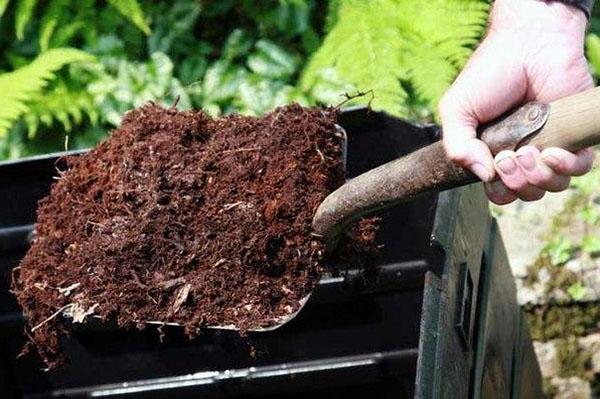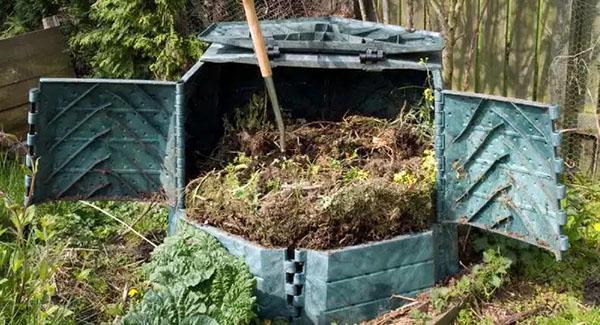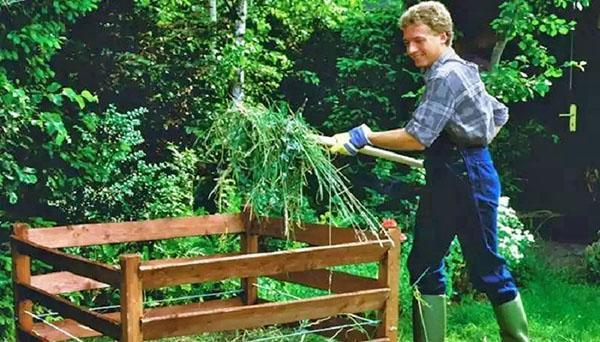Compost from your backyard - useful properties and areas of application
 From year to year, the land on the personal plot is depleted. if you do not deal with the restoration of its composition. Self-made compost is excellent for these purposes. A fertile composition is prepared from waste, grass, humus, which does not require capital investment at all. The only drawback is the long maturation process of the fertilizer. A completely rotted composition is laid out on the beds.
From year to year, the land on the personal plot is depleted. if you do not deal with the restoration of its composition. Self-made compost is excellent for these purposes. A fertile composition is prepared from waste, grass, humus, which does not require capital investment at all. The only drawback is the long maturation process of the fertilizer. A completely rotted composition is laid out on the beds.
How to determine the readiness of compost
How do you know when the compost is completely decomposed and ready for use? This is a fairly popular question among budding gardeners.

Resist the temptation to start composting before it's ready. When using incompletely decomposed compost on the site, microorganisms contained in it can compete with plants due to nitrogen in the soil - as a result, plant growth slows down and they begin to turn yellow. It has also been found that compost that is not yet usable slows seed germination and seedling growth.
Useful properties of compost
 It doesn't matter how long your compost heap takes to decompose - quickly at high temperatures or slowly at low temperatures - once the process is complete, the mixture of components is transformed into a completely new product. The volume of the finished compost is much less than the original heap - by about 30-50%. This occurs as a result of biochemical breakdown and evaporation of water. The finished compost has a lot of useful properties and can significantly enrich the soil in your garden plot.
It doesn't matter how long your compost heap takes to decompose - quickly at high temperatures or slowly at low temperatures - once the process is complete, the mixture of components is transformed into a completely new product. The volume of the finished compost is much less than the original heap - by about 30-50%. This occurs as a result of biochemical breakdown and evaporation of water. The finished compost has a lot of useful properties and can significantly enrich the soil in your garden plot.
Compost improves the quality of almost any type of soil. It improves the composition and consistency of the soil, helps to retain nutrients, water and air - everything that is so necessary for the normal development of plants.
 Compost additives have a beneficial effect on soil composition - the ratio of inorganic components (sand, silt, clay) and organic decay products (compost, humus). In addition, they give the soil a loose consistency that allows water to pass through well, and at the same time retains the required amount in the soil. Compostable soil contains irregularly rounded components. These components are a collection of particles that are weakly connected to each other due to the waste products of earthworms and compost microorganisms - this is what gives the soil a loose texture. If you try to crumble one of these components, it will break down into smaller particles.Loose soil does not interfere with the free access of air, retains moisture well, but at the same time allows excess water to drain down. In addition, it is easier for the tender young roots to penetrate the loose soil.
Compost additives have a beneficial effect on soil composition - the ratio of inorganic components (sand, silt, clay) and organic decay products (compost, humus). In addition, they give the soil a loose consistency that allows water to pass through well, and at the same time retains the required amount in the soil. Compostable soil contains irregularly rounded components. These components are a collection of particles that are weakly connected to each other due to the waste products of earthworms and compost microorganisms - this is what gives the soil a loose texture. If you try to crumble one of these components, it will break down into smaller particles.Loose soil does not interfere with the free access of air, retains moisture well, but at the same time allows excess water to drain down. In addition, it is easier for the tender young roots to penetrate the loose soil.
Well-structured soil is easy to grow any plant - it remains loose all the time, as it consists of many small components. Compost improves all types of soil, but it is especially useful for sandy and clay soils.
Loose sandy soil is almost impossible to form by hand, as it consists of large particles. It does not retain water and nutrients well - nothing interferes with their passage. When compost is added, the constituent components of the soil bind together - this significantly reduces the loss of moisture and nutrients, and also facilitates access to water for the roots.
Clay soil is dense and heavy, since its constituent components are firmly connected to each other. Wet sticky clay is easily formed by hand. Compost helps to bind the clay components to form larger particles. At the same time, the gaps between them increase, which helps the penetration of surface water into the deep layers of the soil, and also ensures the free passage of air.
Compost additions significantly enrich the soil with useful nutrients that are necessary for the normal development of plants: in addition to the three main constituents - nitrogen, phosphorus and potassium, compost contains many trace elements, such as copper, manganese, iron and zinc. The role of microelements is very great - in small doses they are necessary for plants, just as people need vitamins. They also significantly increase the ability of plants to extract essential nutrients from the soil. Often, ready-made fertilizers contain too few trace elements, so compost, in fact, makes up for this deficiency.
Some components of compost decompose quickly and others slowly, so the release of beneficial nutrients takes a long period of time. For this reason, compost is sometimes called delayed fertilizer. The composition of the compost is never constant - it depends on many variables. However, one thing is for sure - the more ingredients are used to make compost, the more valuable the final product will be.
 It has been shown that the nitrogen content of compost changes over time. In the 1st year of use, during the decay of this organic product, 25% of nitrogen is released, in the 2nd and 3rd years - 10%, and in the 4th and 5th years this figure is reduced to 5%.
It has been shown that the nitrogen content of compost changes over time. In the 1st year of use, during the decay of this organic product, 25% of nitrogen is released, in the 2nd and 3rd years - 10%, and in the 4th and 5th years this figure is reduced to 5%.
Compost attracts earthworms, centipedes, woodlice and other living creatures, thus serving as a source of healthy nutrition for them. Organic material passes through their digestive tract and enriches the soil with nutrients. Thus, a balanced environmental friendliness of the soil is maintained.
Research confirms that compost helps to fight not only pests, but also plant diseases. For example, deciduous humus suppresses the development of nematodes, and peat humus protects plants from fungal diseases.
 Compost additions have a positive effect on acidity. Soil nutrients are available to most plants at a pH in the 5.5–7.5 range. As a rule, ready-to-use compost has a neutral pH value, so its additives are able to maintain the soil acidity at the optimum level for plants.
Compost additions have a positive effect on acidity. Soil nutrients are available to most plants at a pH in the 5.5–7.5 range. As a rule, ready-to-use compost has a neutral pH value, so its additives are able to maintain the soil acidity at the optimum level for plants.
Ways to use compost
Mulching
 In nature, plants shed their leaves, which gradually accumulate layer by layer, while the old plant material below begins to decompose. Thus, natural leaf humus is formed, which creates a protective layer over the roots of plants. In summer, it helps to reduce soil temperature and moisture loss, and inhibits weed growth.The same functions can be performed by compost prepared on a personal plot.
In nature, plants shed their leaves, which gradually accumulate layer by layer, while the old plant material below begins to decompose. Thus, natural leaf humus is formed, which creates a protective layer over the roots of plants. In summer, it helps to reduce soil temperature and moisture loss, and inhibits weed growth.The same functions can be performed by compost prepared on a personal plot.
Prepare the soil before mulching. To do this, you first need to remove the weeds and grass along with the roots so that they do not grow through the mulch layer. Carefully check if there are any roots of such perennial weeds as, for example, ivy budra in the ground. Before using the ready-made compost for mulching the soil in flower beds, in the garden, on landscape flower beds or lawns, it must be sieved.
A sieve can be easily made from a ½ inch mesh by attaching it to a wooden frame.
 Place a strainer over a wheelbarrow or large bin and sift the compost. The remaining large pieces on the sieve can be used as an activator in the next compost heap, as they contain the desired microorganisms. Cover the soil in your garden or garden bed with a 2.5–5 cm layer of sifted compost.
Place a strainer over a wheelbarrow or large bin and sift the compost. The remaining large pieces on the sieve can be used as an activator in the next compost heap, as they contain the desired microorganisms. Cover the soil in your garden or garden bed with a 2.5–5 cm layer of sifted compost.
 The compost that you put on the lawn should be finely chopped and well sieved - this will make it more likely that the grass on the lawn will not "suffocate". Compost can also be applied in this way - first loosen the sod with an aerator, and then cover the soil with a very thin layer (no more than 1 cm) of crushed compost. Use a rake to spread the compost evenly.
The compost that you put on the lawn should be finely chopped and well sieved - this will make it more likely that the grass on the lawn will not "suffocate". Compost can also be applied in this way - first loosen the sod with an aerator, and then cover the soil with a very thin layer (no more than 1 cm) of crushed compost. Use a rake to spread the compost evenly.
When mulching trees and shrubs, it is not necessary to sift the compost. It only depends on your desire.
Enriching the soil with nutrients
 Earlier it was said that compost is extremely useful for different types of soil, especially clay and sandy. Before planting plants on your site for the first time, it is recommended to enrich it with useful nutrients. It is easier to add compost during this time than after the plants have already been planted. Cover the soil in your garden with a layer of compost that is 7.5-10 cm thick, and then plow the soil to a depth of 15 cm. If your site is already developed and planted, it will be difficult to compost into the deeper soil layers.
Earlier it was said that compost is extremely useful for different types of soil, especially clay and sandy. Before planting plants on your site for the first time, it is recommended to enrich it with useful nutrients. It is easier to add compost during this time than after the plants have already been planted. Cover the soil in your garden with a layer of compost that is 7.5-10 cm thick, and then plow the soil to a depth of 15 cm. If your site is already developed and planted, it will be difficult to compost into the deeper soil layers.
For perennials, compost needs to be added every time you plant new types of plants or plant existing ones. For annuals, compost additions are applied every spring. Loosen the soil in the area where you plan to plant annuals, and then add compost there.
When planting trees and shrubs compost additions should not exceed 25% of the total soil volume. In some sources, it is recommended not to make compost at all for fear that the roots of trees or shrubs will not grow outside the planting pit. In fact, 1/4 of the compost in the potting mix will not cause this problem. If you are still worried about this, use compost only as mulch.
 If the trees are already planted, it will be difficult to compost deep into the soil. But you can use the method used by professional foresters to add nutrients to the soil. Throughout the entire area under the crown of the tree, make holes in the soil with a diameter of 2.5-5 cm and a depth of about 30 cm, observing the intervals between them about 45 cm. Pour the recommended amount of dry fertilizer at the bottom of each hole, and then cover the hole with compost to the very top. For shrubs, the depth of the holes should be from 20 to 25 cm. In this way, you can enrich the soil with nutrients for 2-3 years.
If the trees are already planted, it will be difficult to compost deep into the soil. But you can use the method used by professional foresters to add nutrients to the soil. Throughout the entire area under the crown of the tree, make holes in the soil with a diameter of 2.5-5 cm and a depth of about 30 cm, observing the intervals between them about 45 cm. Pour the recommended amount of dry fertilizer at the bottom of each hole, and then cover the hole with compost to the very top. For shrubs, the depth of the holes should be from 20 to 25 cm. In this way, you can enrich the soil with nutrients for 2-3 years.
Potting soil mixtures for container plants
 Well-crushed compost can be used as an additive to soil mixtures for growing container plants, while its amount should not exceed 1 / 2–1 / 4 of the total soil volume. The growth and development of container plants depends entirely on a sufficient amount of water and nutrients in the potting mix.Compost does an excellent job with these tasks - it has the ability to retain moisture in the soil and is rich in a variety of nutrients, which in finished fertilizers and soils, as a rule, are contained in insufficient quantities or not at all. Fertilizing the soil regularly is essential to ensure that container-grown plants have enough essential nutrients. Shredded and sifted compost is also excellent for use in potting soil.
Well-crushed compost can be used as an additive to soil mixtures for growing container plants, while its amount should not exceed 1 / 2–1 / 4 of the total soil volume. The growth and development of container plants depends entirely on a sufficient amount of water and nutrients in the potting mix.Compost does an excellent job with these tasks - it has the ability to retain moisture in the soil and is rich in a variety of nutrients, which in finished fertilizers and soils, as a rule, are contained in insufficient quantities or not at all. Fertilizing the soil regularly is essential to ensure that container-grown plants have enough essential nutrients. Shredded and sifted compost is also excellent for use in potting soil.
Liquid fertilizer - compost tea
 This is an old way of plant nutrition. This liquid fertilizer will provide your plantings with a good dose of essential nutrients. Compost tea is especially useful for seedlings and seedlings. To prepare it, fill a bag (or old pillowcase) with the compost and tie the open end tightly. Then place the bag in a container filled with water — an old tub, barrel, or large watering can — and stir it vigorously in the water. After that, let the solution brew for several days. Over time, the liquid will take on the color of a tea, as the water will wash nutrients out of the compost. Spray the prepared compost tea or pour it over the soil around the plants.
This is an old way of plant nutrition. This liquid fertilizer will provide your plantings with a good dose of essential nutrients. Compost tea is especially useful for seedlings and seedlings. To prepare it, fill a bag (or old pillowcase) with the compost and tie the open end tightly. Then place the bag in a container filled with water — an old tub, barrel, or large watering can — and stir it vigorously in the water. After that, let the solution brew for several days. Over time, the liquid will take on the color of a tea, as the water will wash nutrients out of the compost. Spray the prepared compost tea or pour it over the soil around the plants.
The compost bag can be reused to make tea, and the contents should then be emptied anywhere in your garden.